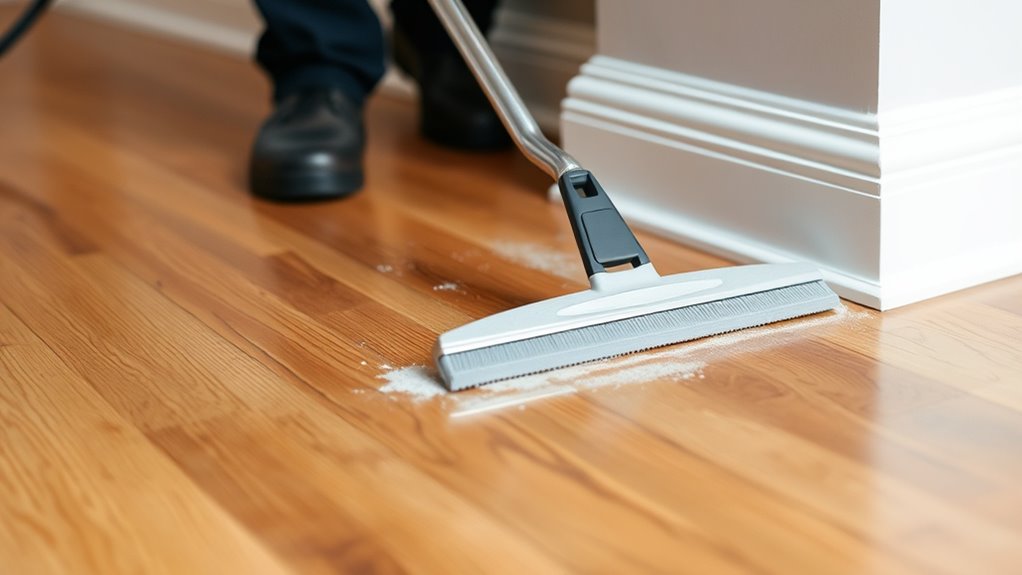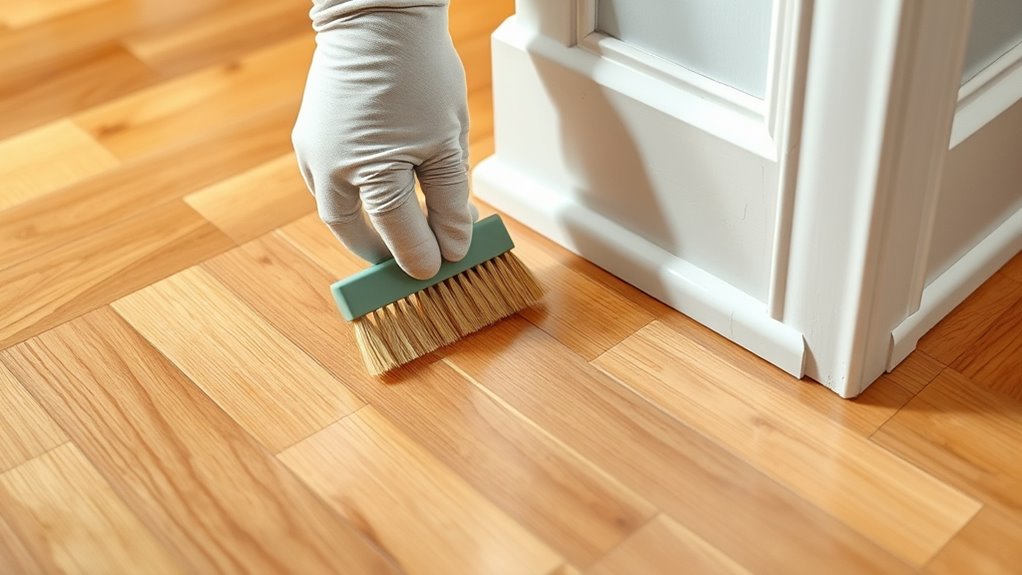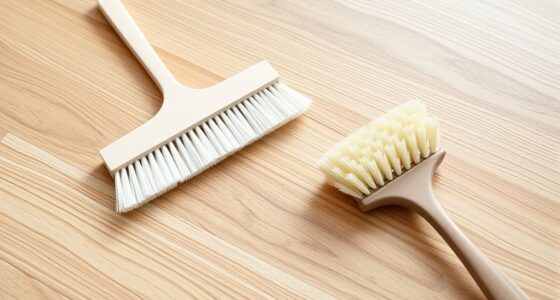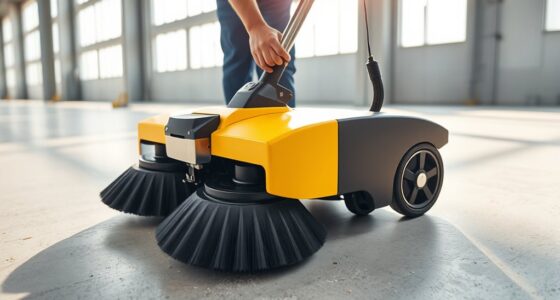To get perfect edge cleanup on hardwood floors, start by removing the baseboards for easier access. Use small brushes or corner tools to dislodge dust and debris, then wipe with a damp cloth—avoiding excess moisture. For tight spaces, employ detail vacuums with narrow attachments to reach every corner. Finishing with a slight seal or touch-up guarantees a polished look. Keep exploring to discover more expert tricks for flawless results.
Key Takeaways
- Remove baseboards carefully to access behind and along edges for a thorough clean.
- Use small brushes or corner tools to dislodge dust and debris in tight corners and along edges.
- Employ narrow attachment vacuums or damp cloths for precise cleaning without damaging hardwood.
- Reattach baseboards securely after cleaning to prevent dirt buildup and maintain a polished look.
- Regular edge maintenance prevents scratches, dirt accumulation, and enhances overall floor appearance.

Cleaning the edges of hardwood floors can be challenging, but paying attention to these often-overlooked areas is essential for a thorough shine. One of the most effective ways to tackle this is by addressing the baseboards directly. Many homeowners skip over baseboard cleaning, but giving these vertical surfaces a proper wipe can make a noticeable difference. To do a really deep clean, some pros even opt for baseboard removal. Carefully detaching the trim allows you to clean behind and beneath it, removing dust, pet hair, and grime that often accumulate unnoticed. Once removed, you can thoroughly scrub the baseboards and the floor edges, then reattach them securely. This process ensures no dirt is hiding in the corners or along the edges, resulting in a cleaner, more polished appearance.
Removing baseboards allows for a deeper clean and a polished finish.
Another key aspect of edge cleanup involves corner trimming. Corners are notorious for trapping dirt and debris because they’re harder to reach with standard mops or vacuums. Using a small brush, like a paintbrush or a dedicated corner cleaning tool, helps dislodge dust and grime from tight spaces. For more stubborn debris, a slightly damp cloth or a detail cleaning tool works wonders. When working around corners, you want to be gentle but thorough, making sure you reach into every nook and cranny. Proper corner trimming isn’t just about aesthetics; it helps maintain the integrity of your hardwood, preventing the buildup of dirt that can cause scratches or damage over time. Additionally, understanding signs of spoilage in lemon juice can help you avoid using spoiled products that might damage your cleaning tools or floors if mishandled.
Some pros also recommend using specialized tools to streamline this process. A detail vacuum with narrow attachments can easily get into tight corners and along baseboards without disturbing the rest of your floor. When cleaning, keep in mind that moisture is your enemy—excess water can warp hardwood, so use damp, not soaked, cloths. After removing baseboards, you might notice gaps or uneven edges that require resealing or touch-up paint, which can enhance the overall look once everything is back in place.
Ultimately, tackling baseboard removal and paying close attention to corner trimming elevates your hardwood floor cleaning routine. It’s a bit more effort upfront, but the payoff is a crisp, spotless edge that complements the beauty of your flooring. This detailed approach ensures your hardwood floors stay looking their best, with no dirt hiding in the corners or along the edges. When you give these often-overlooked areas the attention they deserve, your entire space feels cleaner, brighter, and more polished.
Frequently Asked Questions
What Tools Are Best for Detailed Baseboard Edge Cleaning?
You should use specialized tools like baseboard brushes and detail scrubbers for detailed baseboard edge cleaning. Baseboard brushes have angled bristles that easily reach into corners and tight spots, while detail scrubbers offer gentle scrubbing power for stubborn dirt. Together, these tools help you clean thoroughly without damaging your hardwood floors, making your edge cleanup quick and effective. Always choose tools designed for delicate surfaces to protect your flooring.
How Often Should I Clean the Edges of Hardwood Floors?
You should clean the edges of your hardwood floors at least once a week to maintain proper floor maintenance and dust removal. Regular cleaning prevents dust buildup, which can damage the wood over time. Use a small brush or a microfiber cloth for detailed baseboard edge cleaning. This routine keeps your floors looking fresh, reduces allergens, and extends the life of your hardwood floors by preventing dirt and dust from settling in the corners.
Can I Use a Vacuum for Edge Cleanup Without Damaging the Floor?
You can use a vacuum for edge cleanup, but prioritize vacuum safety to prevent scratches or damage. Opt for a vacuum with a soft brush attachment or adjustable settings to gently clean along baseboards. Incorporate edge cleaning into your regular cleaning schedule to keep floors pristine. By choosing the right vacuum and maintaining consistent routines, you’ll effectively remove dust and debris without harming your hardwood floors.
Are There Eco-Friendly Solutions for Baseboard Edge Cleaning?
Yes, there are eco-friendly solutions for baseboard edge cleaning. You can use natural solutions like a mixture of white vinegar and water or a gentle castile soap diluted in water. These eco-friendly cleaning methods effectively remove dust and grime without harsh chemicals, making them safe for your hardwood floors and the environment. Regularly using natural solutions helps keep your baseboards clean while supporting sustainable living.
How Do I Prevent Damage to Baseboards During Cleaning?
To prevent damage to your baseboards during cleaning, avoid harsh scrubbers that can scratch the paint or wood. Use a soft cloth or microfiber mop to gently remove dust and dirt. Be careful around edges to prevent scratching, especially if your hardwood has a delicate finish. Regular maintenance helps preserve your baseboards’ paint and prevents scratches, keeping them looking fresh and well-maintained without risking damage to the hardwood surface.
Conclusion
Now that you know these pro baseboard tricks, edge cleanup on your hardwood floors becomes easier and more efficient. Imagine tackling a stubborn dirt patch near your living room baseboard and effortlessly getting it spotless with a simple brush or tool. With these tips, you’ll save time and keep your floors looking pristine. Just like Sarah, who transformed her space in minutes, you can achieve professional results right at home—no fuss, just flawless floors.









